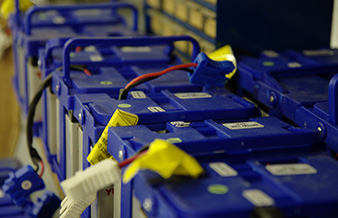CEC publishes guidelines on the recycling of spent lead-acid batteries in North America
Report outlines best practices for recycling this potentially hazardous waste
Montreal, 17 February 2016—The Commission for Environmental Cooperation (CEC) has published a new report providing technical guidelines for the environmentally sound recycling of spent lead-acid batteries (SLABs) in North America.
Spent lead-acid batteries from cars and trucks are one of the most recycled products in the world. In fact, recycling rates are nearly 100 percent in Canada, Mexico and the United States.
When carried out properly, SLAB recycling can be an environmental success story, as recycling provides a stable supply of secondary lead to the battery industry and diverts spent batteries from disposal in the environment. However, poor recycling practices, even on a small scale, can result in serious, long-lasting harm to workers, communities, and the environment.
The CEC Technical Guidelines for the Environmentally Sound Management of Spent Lead-acid Batteries in North America were developed in collaboration with Environment and Climate Change Canada; Mexico’s Secretaría de Medio Ambiente y Recursos Naturales (Semarnat), Procuraduría Federal de Protección al Ambiente (Profepa), and Instituto Nacional de Ecología y Cambio Climático (INECC); and the US Environmental Protection Agency (EPA). The guidelines respond to the findings from an earlier CEC report on SLABs and are based on consultations with relevant stakeholder groups and technical experts in all three countries.
The report identifies and consolidates best practices and technologies for collecting and recycling SLABs in a manner that protects the environment, and the health and safety of workers and the public. It also provides recommendations on how to implement best practices at new and existing SLAB collection, storage and recycling facilities in North America.
To view or download the technical guidelines, visit our Virtual Library at www.cec.org/library.
Keep up-to-date with the CEC’s work by following @CECweb on Twitter or like us on Facebook at www.facebook.com/cecconnect.

About the CEC
The Commission for Environmental Cooperation (CEC) was established in 1994 by the governments of Canada, Mexico and the United States through the North American Agreement on Environmental Cooperation, a parallel environmental agreement to NAFTA. As of 2020, the CEC is recognized and maintained by the Environmental Cooperation Agreement, in parallel with the new Free Trade Agreement of North America. The CEC brings together a wide range of stakeholders, including the general public, Indigenous people, youth, nongovernmental organizations, academia, and the business sector, to seek solutions to protect North America’s shared environment while supporting sustainable development for the benefit of present and future generations
The CEC is governed and funded equally by the Government of Canada through Environment and Climate Change Canada, the Government of the United States of Mexico through the Secretaría de Medio Ambiente y Recursos Naturales, and the Government of the United States of America through the Environmental Protection Agency.